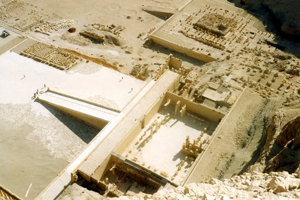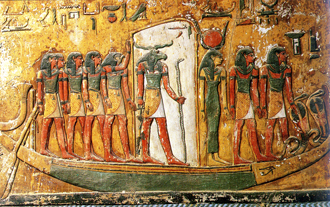Danny takes a route over the hills around Deir el Bahri to get to the Valley of the Kings. I took this route myself when I visited Egypt (although not at night!) Here are some pics:

The view of the Nile valley from above Deir el Bahri


Looking down on the temple Looking down into the Valley of the Kings
The Valley of the Kings
In the New Kingdom (around 1500BC) the Egyptians began burying their pharaohs in a valley on the edge of the desert which they called by various names - The Great Place, The Great Field, and its full name, The Great and Majestic Necropolis of Years of the Pharaoh, Life, Strength, Health, in the West of Thebes. The first pharaoh to be buried here was Hatshepsut's father, Thutmose I, in what we call KV20. Hatshepsut herself was eventually buried there too.
In all 24 pharaohs and various
nobles were buried in the valley - although more tombs may await discovery,
and one was found only last year (KV63 - and in fact there may be another
one, KV64). The most famous tomb of course is KV62 - Tutankhamun's tomb,
which had the most treasure ever found in
any tomb in the world. The other tombs had all been robbed in ancient times.
Quite a lot of goodies were found in the
tomb of Thuya and Yuya (KV46), however.

The best thing about the Valley of the Kings, though, is the fabulous paintings on the tomb walls. These have lasted thousands of years in their glorious bright colours (although some paintings are damaged because of visitors' moist breath). The murals usually show scenes of magic spells such as those from the Book of the Dead or the Amduat - intended to help the pharaoh get to the afterlife. There are many images of the pharaoh and of the gods, and thousands of hieroglyphs.

